C
Qualcomm quick start guide
Qt offers all the necessary tools to design, develop, build, and deploy your application onto the target.
This guide describes how to use the GUIs of Qt tools to develop Linux applications on an Qualcomm device. It describes the overall process and provides step-by-step instructions for the following tasks:
- Designing a simple UI using Qt Design Studio.
- Creating a project in Qt Creator and utilizing the ready-made Boot to Qt image for the Qualcomm device.
- Building and debugging the project on the target device.
Note: Qt for Device Creation requires a license. If you don't have one, you can request a free trial.
Overview
The following figure illustrates the basic concept of the software development process when you're using Qt tools and Boot to Qt Software Stack.
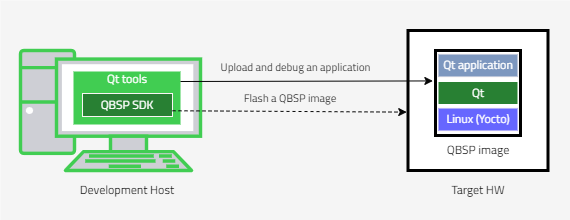
- Development Host is a development computer running Qt tools on Windows, Linux, or macOS.
- Qt tools includes development tools such as Qt Creator and Qt Design Studio, and quality assurance (QA) tools such as Squish.
- QBSP SDK contains a cross-compilation toolchain that is integrated into Qt Creator, and a device image that can be used to boot your device using Boot to Qt Software Stack.
- Target Device is your development target that runs your embedded Linux application.
- Upload and debug an application (via Ethernet, Wi-Fi, or USB). Use Qt Creator to upload and debug your application on the target device.
- Flash a QBSP image represents ways (such as SD card) to install Linux on the target device.
Applicable Qualcomm target devices
The instructions in this guide apply to the following Qualcomm target device:
- Qualcomm RB3 Gen 2 Vision Kit
Note: For more details on the supported target devices and development hosts, see Supported Target Devices and Development Hosts.
Installing Qt development tools
To develop with Boot to Qt Software Stack, you need to install Qt Creator and Qt Design Studio.
If you already have Qt installed, use Qt Maintenance Tool to install any missing tools.
If you don't have Qt installed yet, follow these steps to get Qt Creator and Qt Design Studio:
- Sign in to Qt Customer Portal to download Qt Online Installer.
- The installer is available for the following hosts:
- Linux on Arm
- Linux x86
- macOS
- Windows
- Windows on Arm
Download the installer package that matches your host.
- Open the installer.
- Continue to Installation Folder and select Custom Installation.
- Select Next.
- In Customize, select the following components:
- Qt Design Studio (LTS or latest release)
- Qt Creator
- Select Next.
- Continue to Ready to Install and select Install.
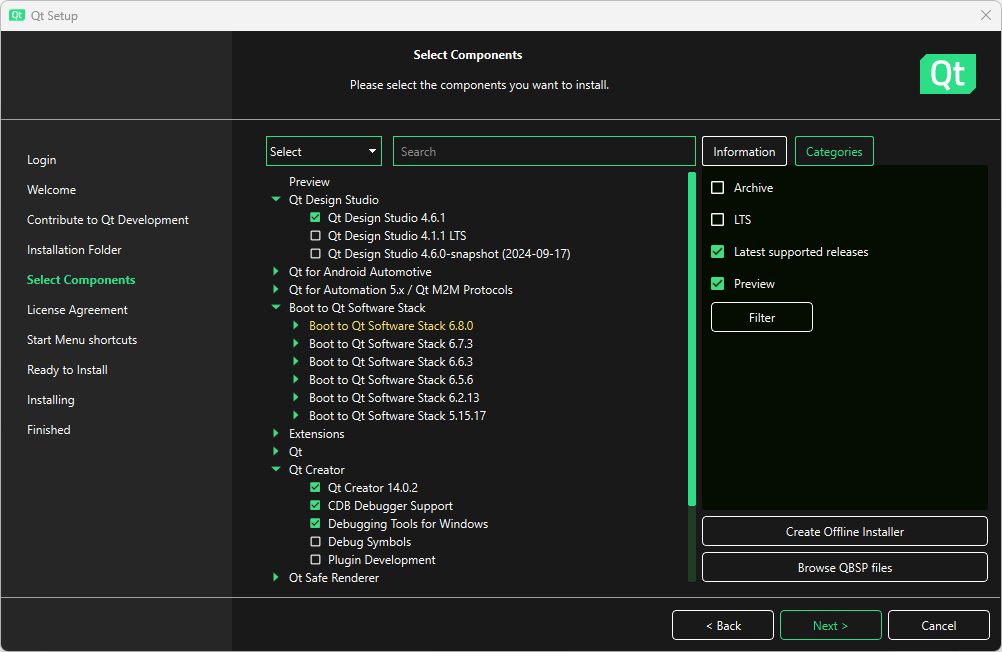
Installing Boot to Qt Software Stack using Qt Maintenance Tool
To install Boot to Qt Software Stack for Qualcomm RB3 Gen 2 Vision Kit, do the following:
- Open Qt Maintenance Tool.
- Continue to Customize and open the top-level Qt for Embedded Linux dropdown menu to find Boot to Qt Software Stack.
- Open the correct Qt release -specific Boot to Qt Software Stack dropdown menu.
- Select Qualcomm RB3 Gen 2 Vision Kit.
- Continue to Ready to Update and select Update.
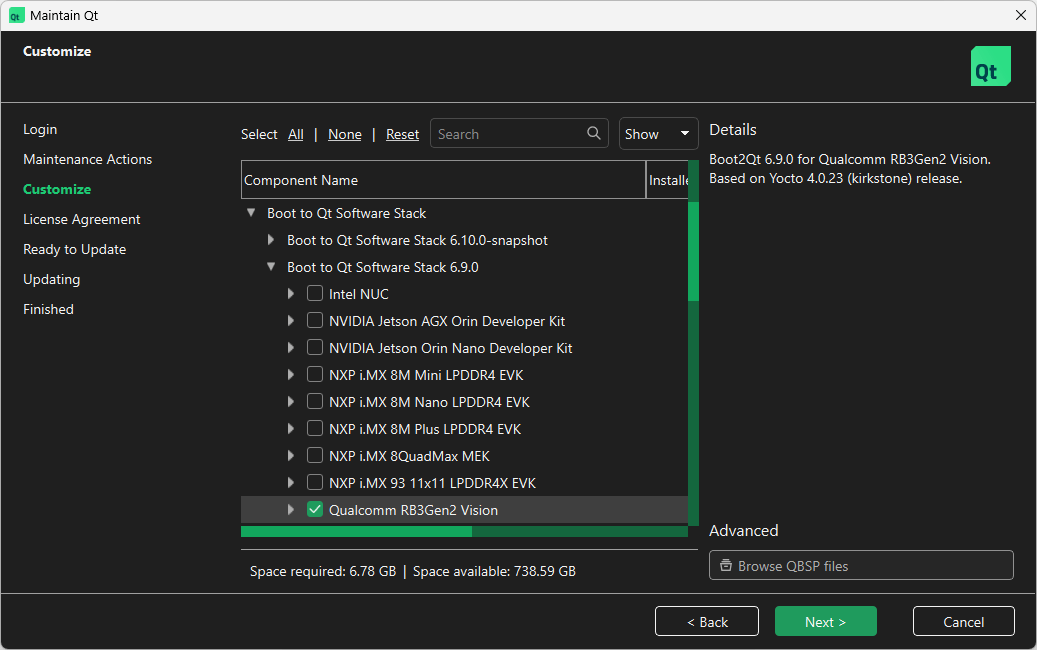
Installing Boot to Qt on the target device
Before you can test your Qt applications on the target device, you must flash the target device with an image containing the Boot to Qt Software Stack. After you have successfully flashed your device, Boot to Qt Demo Launcher appears on the screen when you power on the device.
Note: Qt Flashing Wizard is not applicable to this device.
Flashing Boot to Qt Image on the target device
Flashing is supported only on a Linux-compatible host.
Note: Before you start flashing, update the universal flash storage (UFS) and flash configuration data table (CDT) on the target device. For more information on how to do this, see Qualcomm documentation.
Flash the Boot to Qt image to your device as follows:
- Add or update
udevrules as instructed in Update udev rules. - Connect the target device to your host with a suitable USB-C cable.
- Put the target device into Emergency Download (EDL) mode. For more information on how to do this, see Move to EDL mode.
- Build Qualcomm Download (QDL) tool as instructed in How to build a standalone QDL?.
- Run the following scripts to flash the image to your device:
cd <INSTALL_DIR>/6.12.0/Boot2Qt/qcs6490-rb3gen2-vision-kit/images/b2qt-embedded-qt6-image-qcs6490-rb3gen2-vision-kit <path-to-qdl>/qdl prog_firehose_ddr.elf rawprogram*.xml patch*.xml
The Qualcomm device starts with Boot to Qt Demo Launcher application by default. If you want to check the IP address of the device, open Get Started with Boot to Qt via Boot to Qt Demo Launcher. The IP address is shown if the device is connected to an Ethernet or Wi-Fi network, or to the host computer via USB OTG.
For more information on flashing Qualcomm RB3 Gen 2 Vision Kit devices, see Github: qualcomm-linux/meta-qcom.
Connecting the target device
Create a connection between the target device and Qt Creator to run, debug, and analyze applications on it. The sections below describe how to set up a device using either USB, Ethernet, or Wi-Fi connectivity.
Connecting the target device via USB
The target device can be connected to the host via USB On-the-Go (OTG). Once connected via a USB network, the device is automatically added to Devices in Qt Creator.
Connecting the target device via Ethernet or Wi-Fi
Connect your target device to network either via Ethernet or Wi-Fi connectivity.
To connect via Ethernet, use the RJ45 port. To connect via Wi-Fi, set up a Wi-Fi connection from Boot to Qt Demo Launcher.
After your target device is connected and has an IP address, set it up to be used in Qt Creator with the following steps:
- Open Qt Creator.
- Select Edit > Preferences.
- In the Preferences window:
- Select Devices.
- Select Add > Boot2Qt Device > Start Wizard.
- In the Boot2Qt Network Device Setup window:
- Enter the Device name.
- Enter the Device address (IP address of the Qualcomm device).
- Select Finish.
- On the Devices tab, select OK.
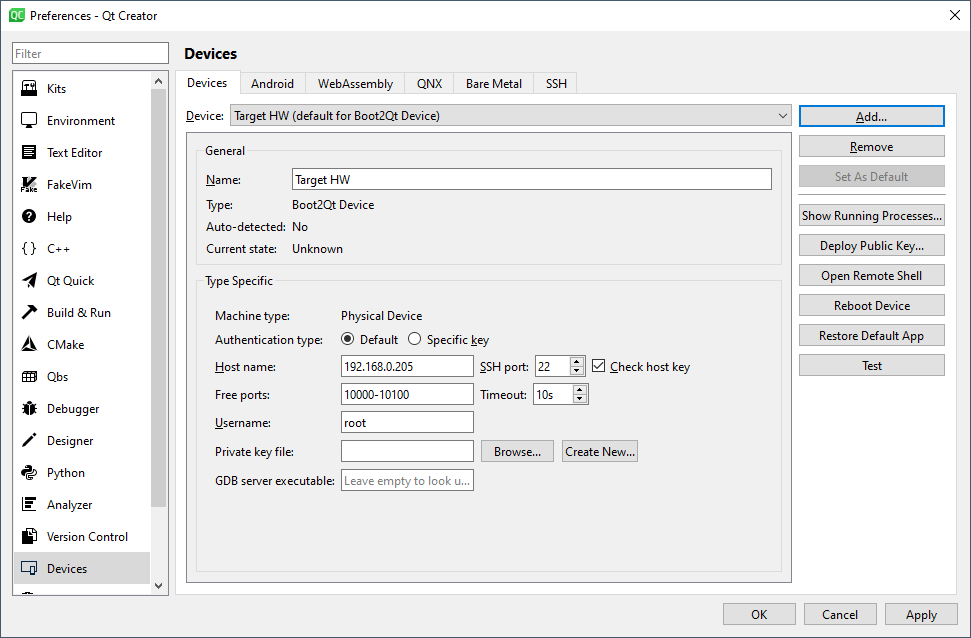
Note: Qt Creator uploads the application over the IP network, so your target device has to be in the same network as your development host.
Creating an application UI in Qt Design Studio
Create a cross-platform UI with Qt Design Studio, also for embedded Linux applications, with the following steps:
- Open Qt Design Studio.
- Select Create Project.
- In Presets, select General.
- Name your project. Pay attention to the project path—later on, you open your project from this location with Qt Creator.
- Adjust display resolution and orientation to suit your display.
- Make sure your Target Qt Version matches the version of Qt installed on your machine.
- Select Create.
- Select File > Export Project > Enable CMake Generator. With the resulting CMakeLists.txt file, you can open your project via Qt Creator.
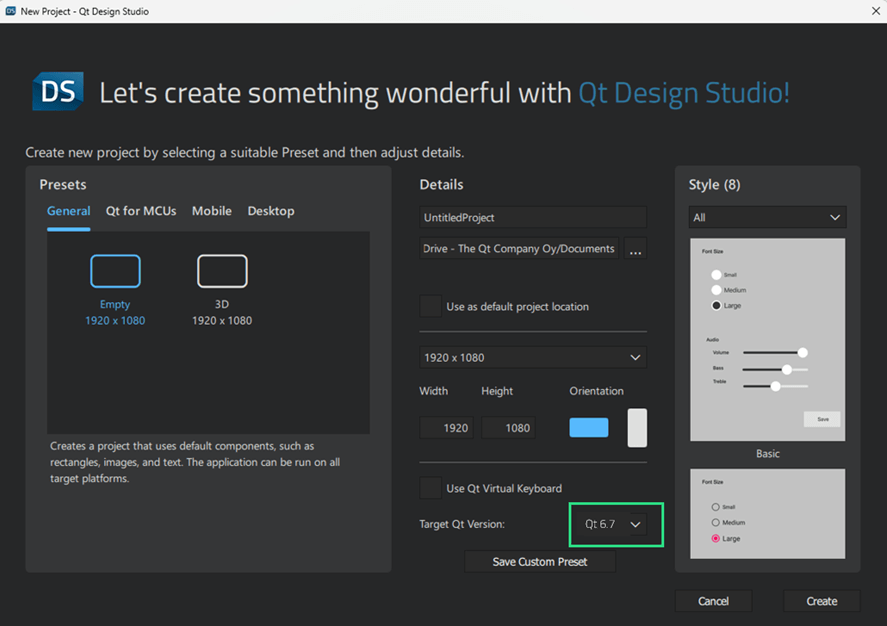
Now you can modify your UI as you wish. Once it's ready, select Save All to make sure that you can open your UI project in Qt Creator.
Configuring and building an application in Qt Creator
To configure and build an application in Qt Creator, follow these steps:
- Open Qt Creator.
- Navigate to the project you created with Qt Design Studio.
- Select CMakeLists.txt to open the project.
- In the Configure Project window:
- Select your Qualcomm kit.
- Select Configure Project.
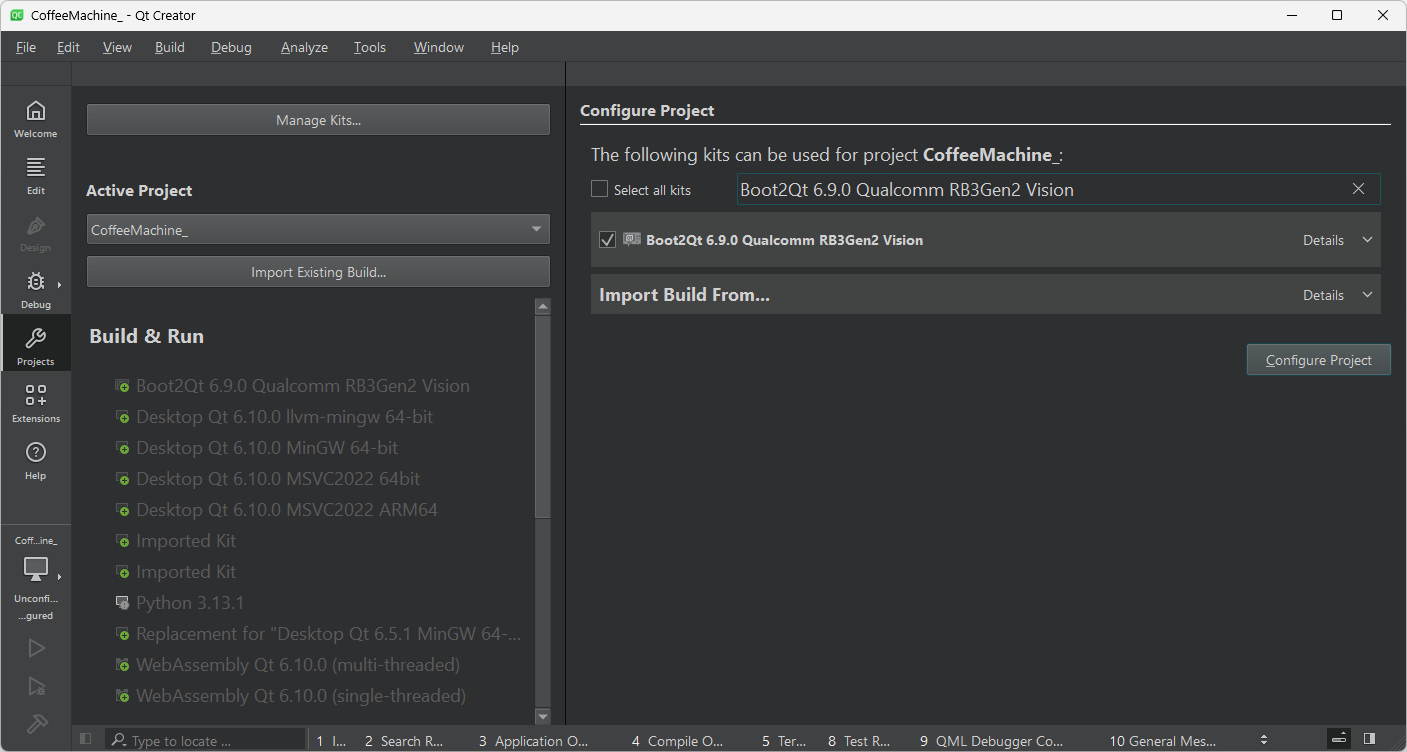
Finally, select Build > Build Project to build the project you configured.
Running an application on the target device
After setting up your device, you can upload and start your application on the Qualcomm device as follows:
- Open Qt Creator.
- Select File > Open File or Project.
- Navigate to the project you configured earlier and select Open.
- In the Projects window:
- Edit the Run Settings if necessary.
- Select Run.
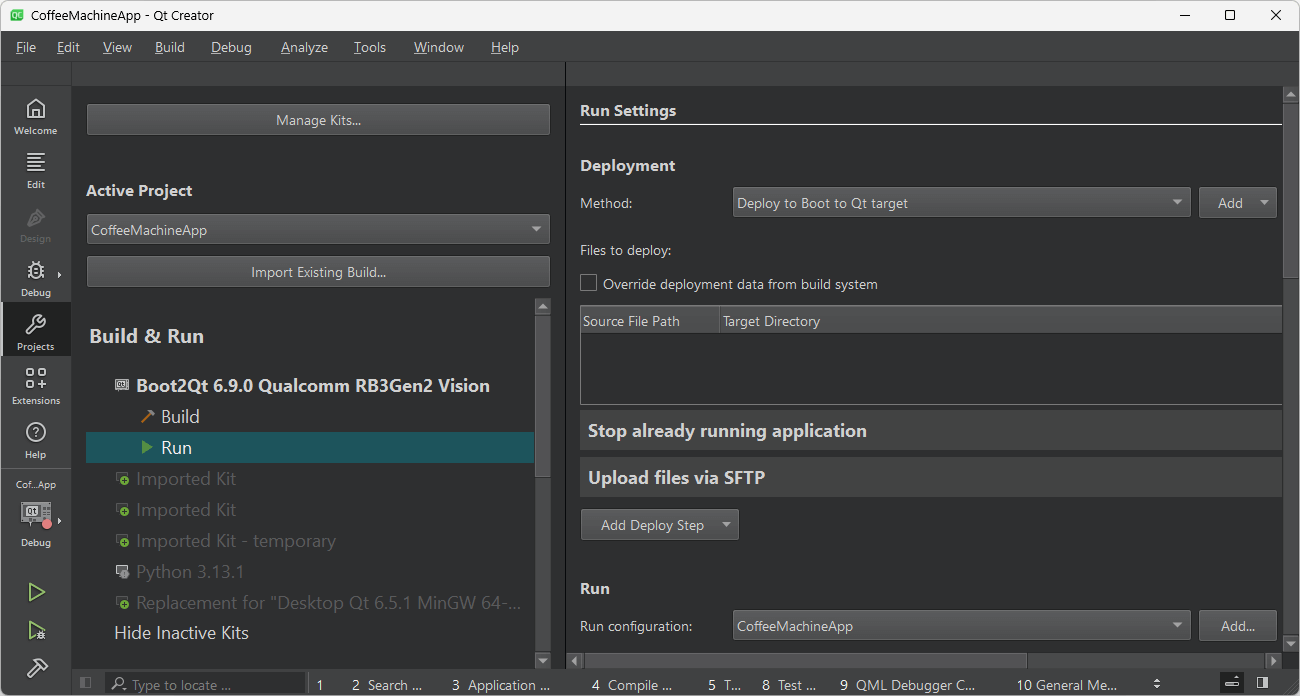
Note: To make changes to your application, you can update it on the device simply by running it again.
For more information on how to deploy Qt projects to the device, see Tutorial: Deploying your first project with Boot to Qt.
Debugging an application
For more information on using Qt Creator to debug an application, see Debugging.
Customizing Boot to Qt for a Qualcomm device
Boot to Qt for embedded Linux is built using the tools and resources from the Yocto Project. For more information on how to set up a building environment for building Boot to Qt, see Setting up environment for building Boot to Qt.
The following steps provide an example on how to build Boot to Qt for an Qualcomm device:
- Initialize the build environment from the manifest repository.
cd <BuildDir> repo init -u https://code.qt.io/yocto/boot2qt-manifest -m qcom-hwe/v6.12.0.xml repo sync
Note: In the example above
qcom-hwe/v6.12.0.xmlrefers to a specific Boot to Qt version, but you can use any version that is compatible with your target device. - Configure the build environment for Linux.
export MACHINE=qcs6490-rb3gen2-vision-kit && source ./setup-environment.sh
- Start building a QBSP for Boot to Qt.
bitbake meta-b2qt-embedded-qbsp
After the build has been completed, you can find the QBSP file at
boot2qt/build-qcs6490-rb3gen2-vision-kit/tmp/deploy/qbsp/meta-b2qt-embedded-qbsp-x86_64-qcs6490-rb3gen2-vision-kit-6.12.0.qbsp.
For more information on how to create a custom Boot to Qt image, see How to create a Boot to Qt image.
Troubleshooting
If you have any issues with your Qualcomm device, turn to Qualcomm Support Forums for more information.
For more information on troubleshooting Boot to Qt, see Troubleshooting.
Available under certain Qt licenses.
Find out more.

